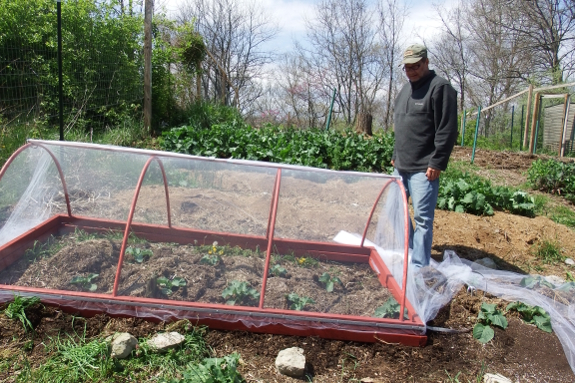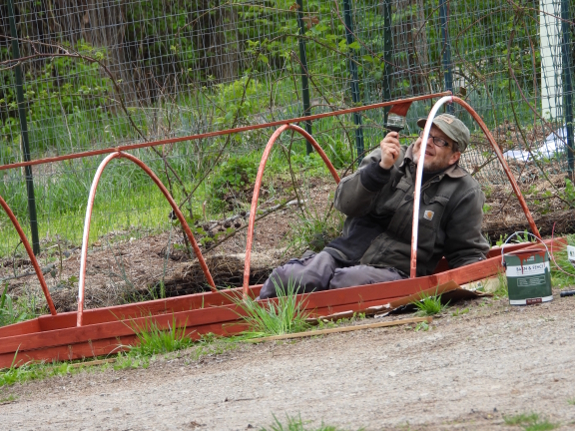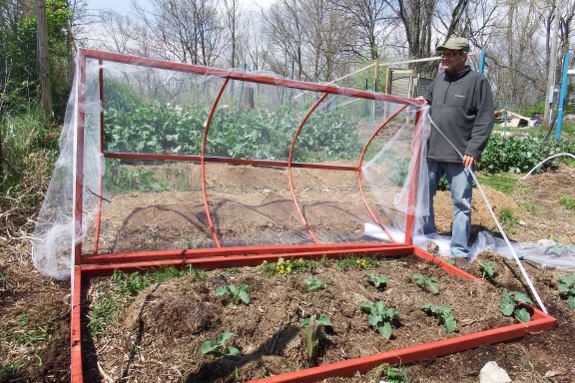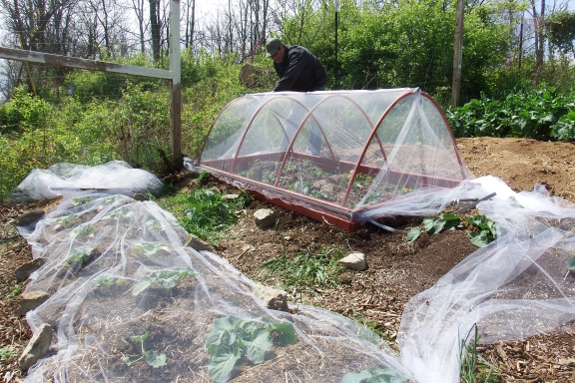
Caterpillar tunnels: Hinged quick hoops for pest control

Mark's taken advantage of the lockdown to perfect a prototype for what
we're calling caterpillar tunnels. The idea is to block cabbage white
moths from laying their eggs on crucifers. I've used row-cover fabric
for this purpose in the past, but the thicker cloth overheats
cool-weather crops. Plus, Mark wanted to improve upon my quick hoops,
which are a bit of a pain for frequent ingress.
To cut a long story short, he tweaked and came up with a no-work
organic solution for controlling of one of my least favorite pests ---
cabbageworms. Of course, I mean no work for me once the caterpillar
tunnels are installed. Building them was work for Mark!

He started with 2X3s, a compromise between what he wanted (2X6s for
longevity, but which I argued would shade plants too much and be too
heavy) and what I wanted (2X2s, which he considered too flimsy). It
still counts as meeting in the middle if he comes almost all the way
over to my side of the fence, right?

After building two frames out of 2X3s and hinging them together along
one long side, Mark used a 3/4-inch hole saw to install our usual quick
hoop pipes (1/2-inch PVC). Your measurements can match your garden, but
ours were:
- Frame --- 8 feet by 4 feet for maximum use of lumber
- Pipes --- 6 feet long

A furring strip along the top gave the hoops a bit more rigidity while
also providing something for the eventual covering to bite into. Since
we didn't have treated lumber on hand, Mark gave it all a good coat of
barn paint.

Oh, and did I mention handles? For the first prototype, Mark had some
really awesome storebought handles to use. But for the later ones, he's
building our own out of wood.

Anyway, back to the prototype. We covered it with wedding tulle, which will let
air and light through (meaning it's summer-garden friendly) without
allowing in bugs. Various forums suggest this stuff lasts almost as
long as the much-more-expensive garden netting you can buy from
farm-supply sites.

How did we attach the tulle? Mark used plastic plumbers' strapping plus
screws --- fast and easy as long as he borrowed another set of hands
(mine) to hold the tulle in place.
Did you notice the small rip? Be careful! Splinters can damage your
covering as you pull the fabric tight.

Mark also used the plumber's strapping to prevent the top from hinging
all the way open. This way, it won't fall on the bed behind it and is
easy to grab and pull back closed.

Here's the finished product, taking over for my quick-and-dirty
tulle-only covering. The broccoli are enjoying having room to stretch
out.
Oh, but, honey, I need three more....
Want more in-depth information? Browse through our books.
Or explore more posts by date or by subject.
About us: Anna Hess and Mark Hamilton spent over a decade living self-sufficiently in the mountains of Virginia before moving north to start over from scratch in the foothills of Ohio. They've experimented with permaculture, no-till gardening, trailersteading, home-based microbusinesses and much more, writing about their adventures in both blogs and books.
Want to be notified when new comments are posted on this page? Click on the RSS button after you add a comment to subscribe to the comment feed, or simply check the box beside "email replies to me" while writing your comment.

Hello out there! Great tip on the tulle. I just watched a little cabbage white float around and drop some eggs on our kale. Do you think black tulle might work as an alternative to shade cloth? Or perhaps just the white in a few layers could work..? Really enjoying the tips on here as an Ohio gardener.
Sarah